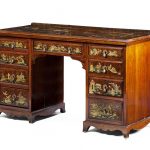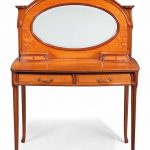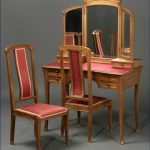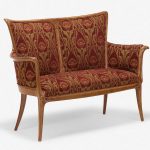Walnut dressing tables. The common walnut, and the black walnut and its allies, are important for their attractive timber, which is hard, dense, tight-grained and polishes to a very smooth finish. The color is dark chocolate or similar in the heartwood changing by a sharp boundary to creamy white in the sapwood. When kiln-dried, walnut wood tends toward a dull brown color, but when air-dried can become a rich purplish-brown. Because of its color, hardness and grain, it is a prized furniture and carving wood. Reference: Wikipedia
Below are some examples and price guides of some Art Nouveau walnut dressing tables including a walnut and chinoiserie dressing table and a French suite.
AN EDWARDIAN WALNUT AND CHINOISERIE DECORATED DRESSING TABLE, FIRST HALF 20TH CENTURY The rectangular top decorated with oriental figures, pagodas within a stylised landscape above nine similarly decorated drawers arranged around a central knee hole.
Sold for £ 812 inc. premium at Bonham’s in 2011
AN ART NOUVEAU WALNUT AND SATINWOOD DRESSING TABLE CIRCA 1900, bevelled mirror enclosed by carved uprights and flowers and leaves, the top having two short drawers, and two below, on carved and tapered supports
Sold for GBP 3,000 at Christie’s in 2014
French Art Nouveau walnut dressing table & chairs
early 20th century, the dressing table with a tripartite hinged bevelled mirror surmounted by a foliate clasp, above a pair of drawers, over a red damask lined serpentine outset top above one long drawer over a kneehole flanked by two pairs of drawers, on chanelled downswept legs, the chairs each with a similarly carved crestrail over a curved slat back and seat covered in red damask, on downswept legs
Sold for $1,200 at John Moran Auctioneers, Inc. in 2007




